Financial Resources Management Report for Metro Products Ltd.
VerifiedAdded on 2020/01/16
|10
|3260
|161
Report
AI Summary
This report provides a comprehensive overview of financial resource management, focusing on the legal and operational aspects relevant to businesses. It begins by differentiating between the legal requirements of limited and non-limited companies, highlighting differences in minimum members, paid-up capital, director roles, and statutory meeting obligations. The report then contrasts management and financial accounting, emphasizing their distinct objectives, information provided, and decision-making support. A significant portion of the report is dedicated to the importance of financial statements, including cash flow statements, profit and loss accounts, retained earnings, and balance sheets, with specific relevance to Metro Products Ltd. Furthermore, the report identifies and analyzes the various stakeholders of a manufacturing company like Metro Products Ltd., including shareholders/investors, customers, employees, suppliers, the local community, competitors, creditors, and government regulatory bodies, and discusses strategies for managing their interests. This report offers valuable insights into financial management practices and stakeholder engagement within a corporate context.
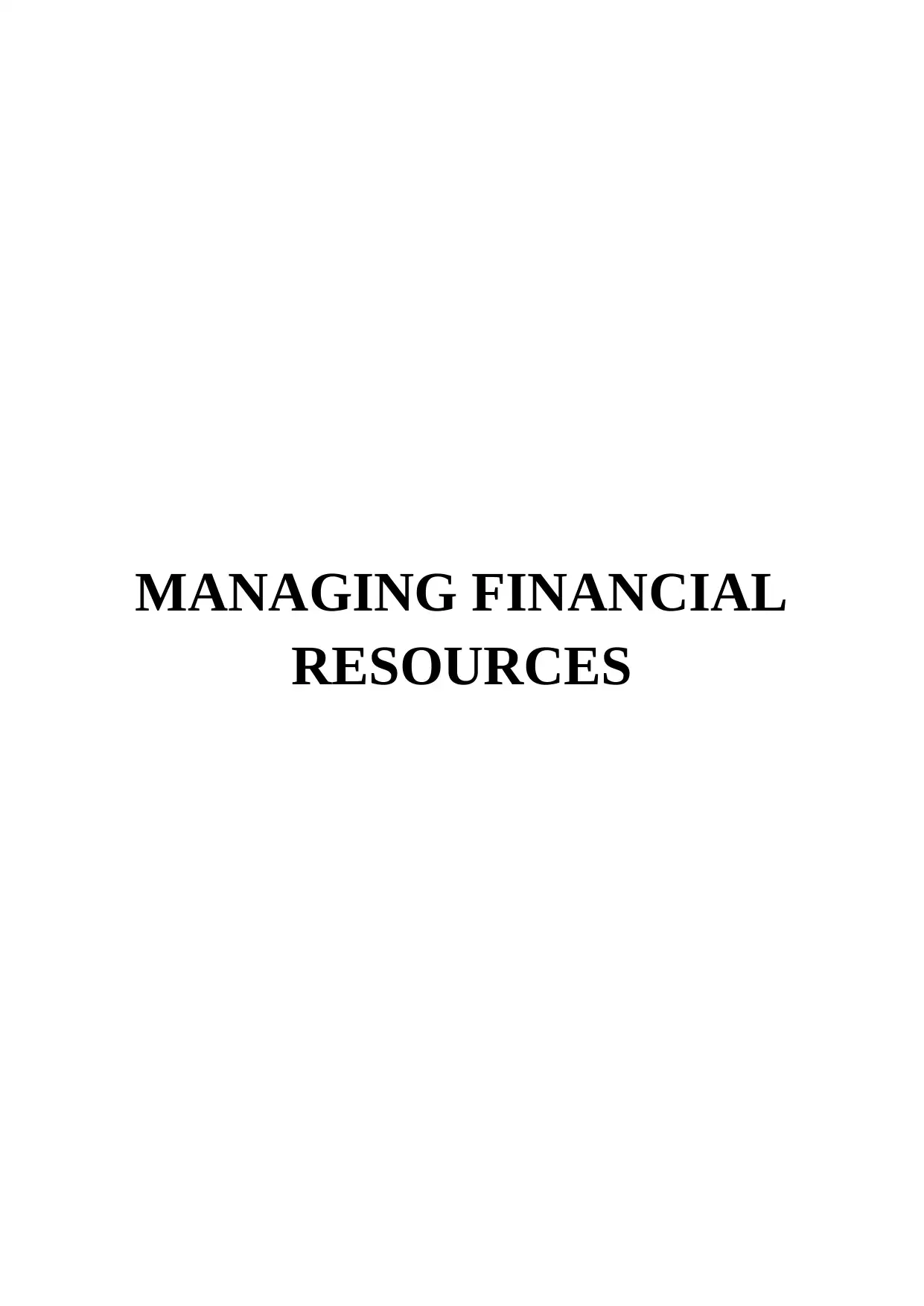
MANAGING FINANCIAL
RESOURCES
RESOURCES
Paraphrase This Document
Need a fresh take? Get an instant paraphrase of this document with our AI Paraphraser
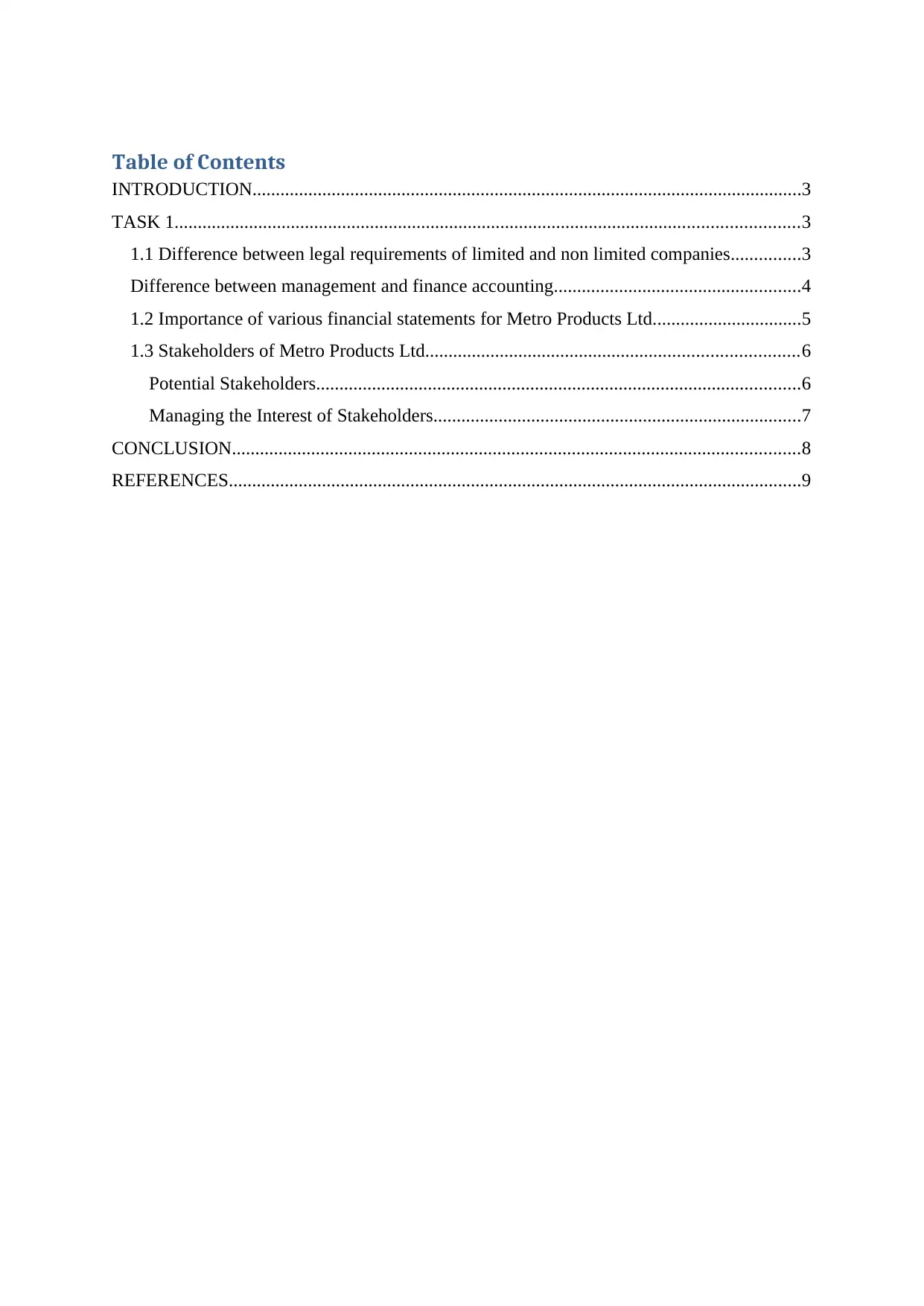
Table of Contents
INTRODUCTION......................................................................................................................3
TASK 1......................................................................................................................................3
1.1 Difference between legal requirements of limited and non limited companies...............3
Difference between management and finance accounting.....................................................4
1.2 Importance of various financial statements for Metro Products Ltd................................5
1.3 Stakeholders of Metro Products Ltd................................................................................6
Potential Stakeholders........................................................................................................6
Managing the Interest of Stakeholders...............................................................................7
CONCLUSION..........................................................................................................................8
REFERENCES...........................................................................................................................9
INTRODUCTION......................................................................................................................3
TASK 1......................................................................................................................................3
1.1 Difference between legal requirements of limited and non limited companies...............3
Difference between management and finance accounting.....................................................4
1.2 Importance of various financial statements for Metro Products Ltd................................5
1.3 Stakeholders of Metro Products Ltd................................................................................6
Potential Stakeholders........................................................................................................6
Managing the Interest of Stakeholders...............................................................................7
CONCLUSION..........................................................................................................................8
REFERENCES...........................................................................................................................9
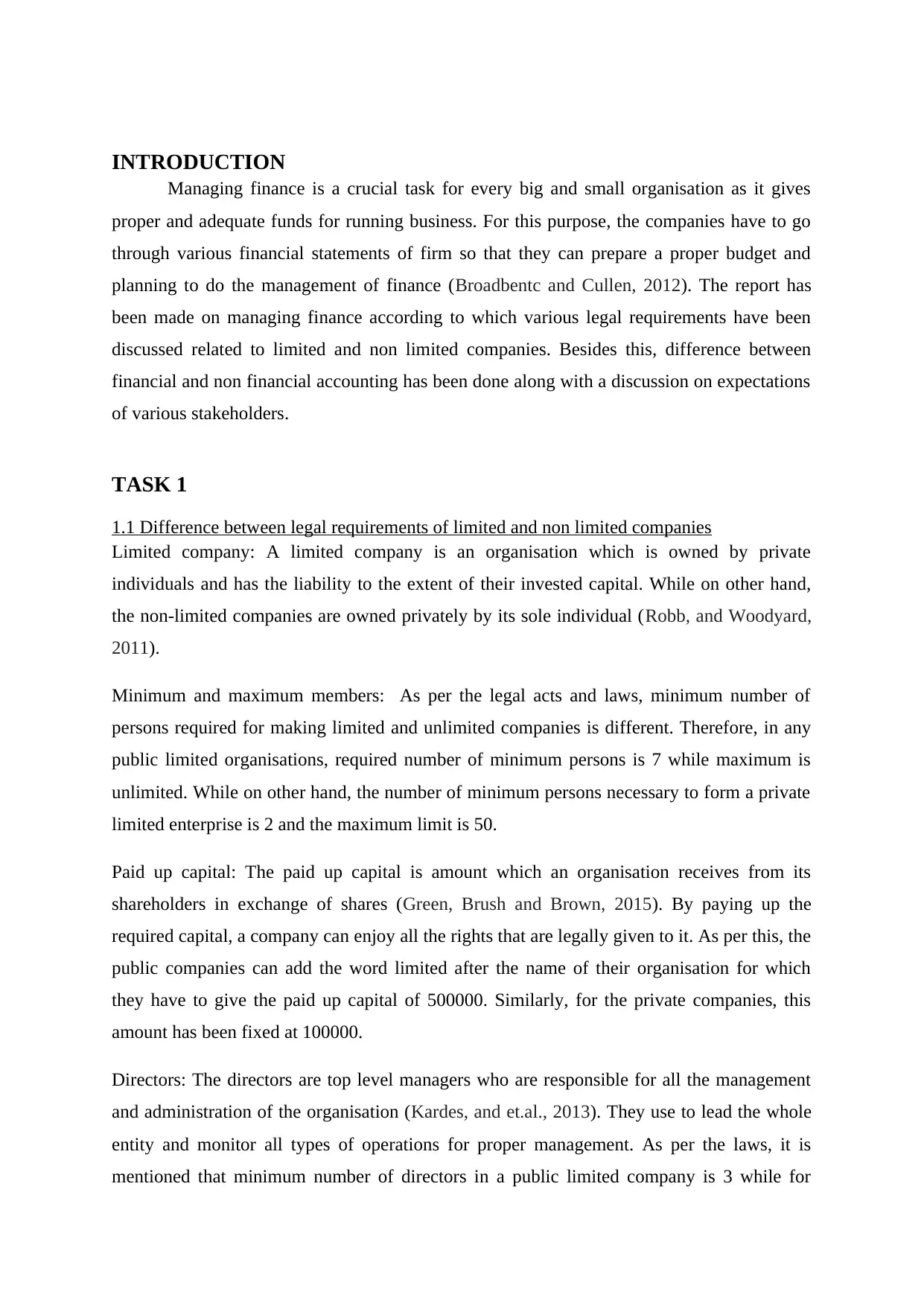
INTRODUCTION
Managing finance is a crucial task for every big and small organisation as it gives
proper and adequate funds for running business. For this purpose, the companies have to go
through various financial statements of firm so that they can prepare a proper budget and
planning to do the management of finance (Broadbentc and Cullen, 2012). The report has
been made on managing finance according to which various legal requirements have been
discussed related to limited and non limited companies. Besides this, difference between
financial and non financial accounting has been done along with a discussion on expectations
of various stakeholders.
TASK 1
1.1 Difference between legal requirements of limited and non limited companies
Limited company: A limited company is an organisation which is owned by private
individuals and has the liability to the extent of their invested capital. While on other hand,
the non-limited companies are owned privately by its sole individual (Robb, and Woodyard,
2011).
Minimum and maximum members: As per the legal acts and laws, minimum number of
persons required for making limited and unlimited companies is different. Therefore, in any
public limited organisations, required number of minimum persons is 7 while maximum is
unlimited. While on other hand, the number of minimum persons necessary to form a private
limited enterprise is 2 and the maximum limit is 50.
Paid up capital: The paid up capital is amount which an organisation receives from its
shareholders in exchange of shares (Green, Brush and Brown, 2015). By paying up the
required capital, a company can enjoy all the rights that are legally given to it. As per this, the
public companies can add the word limited after the name of their organisation for which
they have to give the paid up capital of 500000. Similarly, for the private companies, this
amount has been fixed at 100000.
Directors: The directors are top level managers who are responsible for all the management
and administration of the organisation (Kardes, and et.al., 2013). They use to lead the whole
entity and monitor all types of operations for proper management. As per the laws, it is
mentioned that minimum number of directors in a public limited company is 3 while for
Managing finance is a crucial task for every big and small organisation as it gives
proper and adequate funds for running business. For this purpose, the companies have to go
through various financial statements of firm so that they can prepare a proper budget and
planning to do the management of finance (Broadbentc and Cullen, 2012). The report has
been made on managing finance according to which various legal requirements have been
discussed related to limited and non limited companies. Besides this, difference between
financial and non financial accounting has been done along with a discussion on expectations
of various stakeholders.
TASK 1
1.1 Difference between legal requirements of limited and non limited companies
Limited company: A limited company is an organisation which is owned by private
individuals and has the liability to the extent of their invested capital. While on other hand,
the non-limited companies are owned privately by its sole individual (Robb, and Woodyard,
2011).
Minimum and maximum members: As per the legal acts and laws, minimum number of
persons required for making limited and unlimited companies is different. Therefore, in any
public limited organisations, required number of minimum persons is 7 while maximum is
unlimited. While on other hand, the number of minimum persons necessary to form a private
limited enterprise is 2 and the maximum limit is 50.
Paid up capital: The paid up capital is amount which an organisation receives from its
shareholders in exchange of shares (Green, Brush and Brown, 2015). By paying up the
required capital, a company can enjoy all the rights that are legally given to it. As per this, the
public companies can add the word limited after the name of their organisation for which
they have to give the paid up capital of 500000. Similarly, for the private companies, this
amount has been fixed at 100000.
Directors: The directors are top level managers who are responsible for all the management
and administration of the organisation (Kardes, and et.al., 2013). They use to lead the whole
entity and monitor all types of operations for proper management. As per the laws, it is
mentioned that minimum number of directors in a public limited company is 3 while for
⊘ This is a preview!⊘
Do you want full access?
Subscribe today to unlock all pages.

Trusted by 1+ million students worldwide
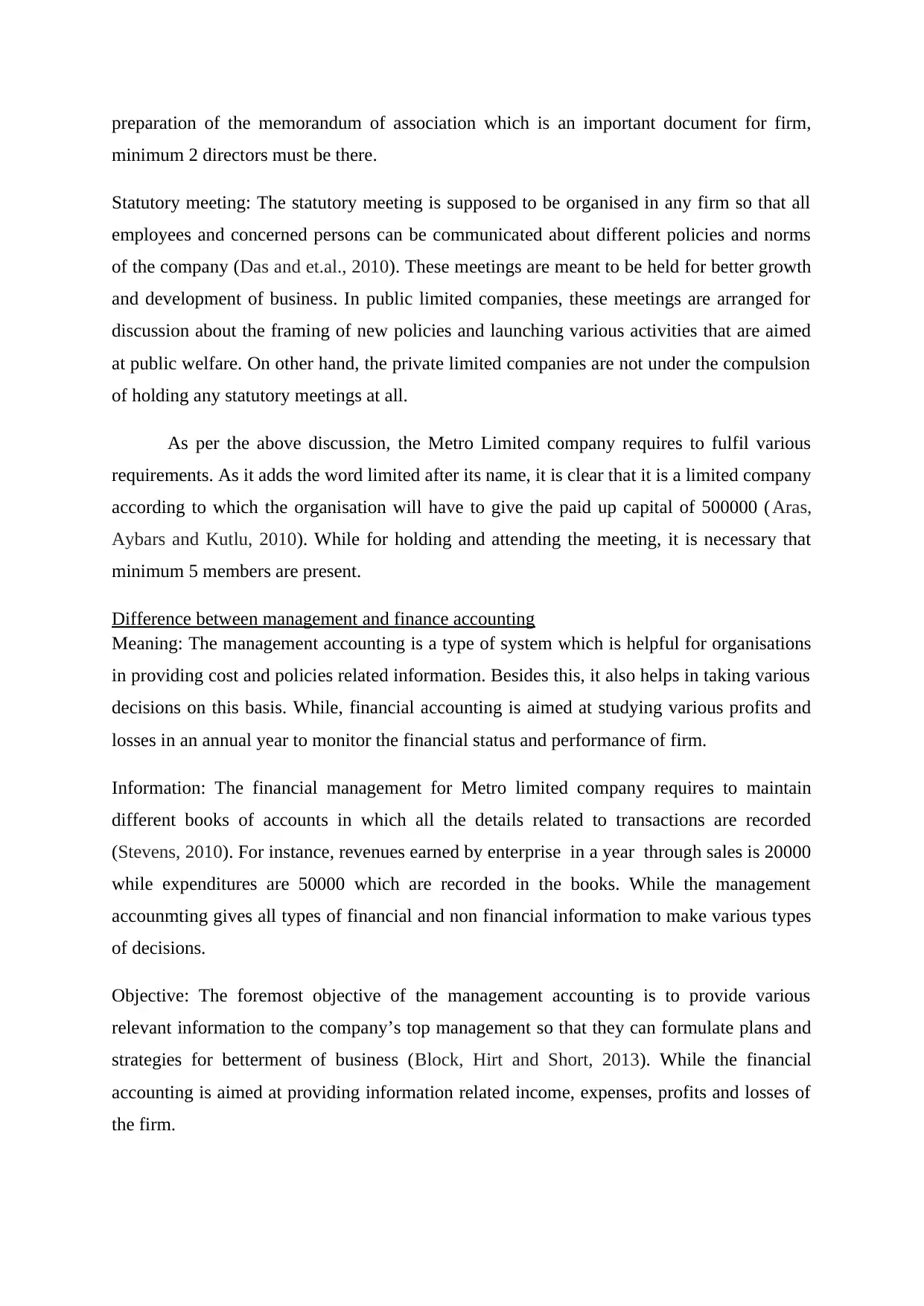
preparation of the memorandum of association which is an important document for firm,
minimum 2 directors must be there.
Statutory meeting: The statutory meeting is supposed to be organised in any firm so that all
employees and concerned persons can be communicated about different policies and norms
of the company (Das and et.al., 2010). These meetings are meant to be held for better growth
and development of business. In public limited companies, these meetings are arranged for
discussion about the framing of new policies and launching various activities that are aimed
at public welfare. On other hand, the private limited companies are not under the compulsion
of holding any statutory meetings at all.
As per the above discussion, the Metro Limited company requires to fulfil various
requirements. As it adds the word limited after its name, it is clear that it is a limited company
according to which the organisation will have to give the paid up capital of 500000 ( Aras,
Aybars and Kutlu, 2010). While for holding and attending the meeting, it is necessary that
minimum 5 members are present.
Difference between management and finance accounting
Meaning: The management accounting is a type of system which is helpful for organisations
in providing cost and policies related information. Besides this, it also helps in taking various
decisions on this basis. While, financial accounting is aimed at studying various profits and
losses in an annual year to monitor the financial status and performance of firm.
Information: The financial management for Metro limited company requires to maintain
different books of accounts in which all the details related to transactions are recorded
(Stevens, 2010). For instance, revenues earned by enterprise in a year through sales is 20000
while expenditures are 50000 which are recorded in the books. While the management
accounmting gives all types of financial and non financial information to make various types
of decisions.
Objective: The foremost objective of the management accounting is to provide various
relevant information to the company’s top management so that they can formulate plans and
strategies for betterment of business (Block, Hirt and Short, 2013). While the financial
accounting is aimed at providing information related income, expenses, profits and losses of
the firm.
minimum 2 directors must be there.
Statutory meeting: The statutory meeting is supposed to be organised in any firm so that all
employees and concerned persons can be communicated about different policies and norms
of the company (Das and et.al., 2010). These meetings are meant to be held for better growth
and development of business. In public limited companies, these meetings are arranged for
discussion about the framing of new policies and launching various activities that are aimed
at public welfare. On other hand, the private limited companies are not under the compulsion
of holding any statutory meetings at all.
As per the above discussion, the Metro Limited company requires to fulfil various
requirements. As it adds the word limited after its name, it is clear that it is a limited company
according to which the organisation will have to give the paid up capital of 500000 ( Aras,
Aybars and Kutlu, 2010). While for holding and attending the meeting, it is necessary that
minimum 5 members are present.
Difference between management and finance accounting
Meaning: The management accounting is a type of system which is helpful for organisations
in providing cost and policies related information. Besides this, it also helps in taking various
decisions on this basis. While, financial accounting is aimed at studying various profits and
losses in an annual year to monitor the financial status and performance of firm.
Information: The financial management for Metro limited company requires to maintain
different books of accounts in which all the details related to transactions are recorded
(Stevens, 2010). For instance, revenues earned by enterprise in a year through sales is 20000
while expenditures are 50000 which are recorded in the books. While the management
accounmting gives all types of financial and non financial information to make various types
of decisions.
Objective: The foremost objective of the management accounting is to provide various
relevant information to the company’s top management so that they can formulate plans and
strategies for betterment of business (Block, Hirt and Short, 2013). While the financial
accounting is aimed at providing information related income, expenses, profits and losses of
the firm.
Paraphrase This Document
Need a fresh take? Get an instant paraphrase of this document with our AI Paraphraser
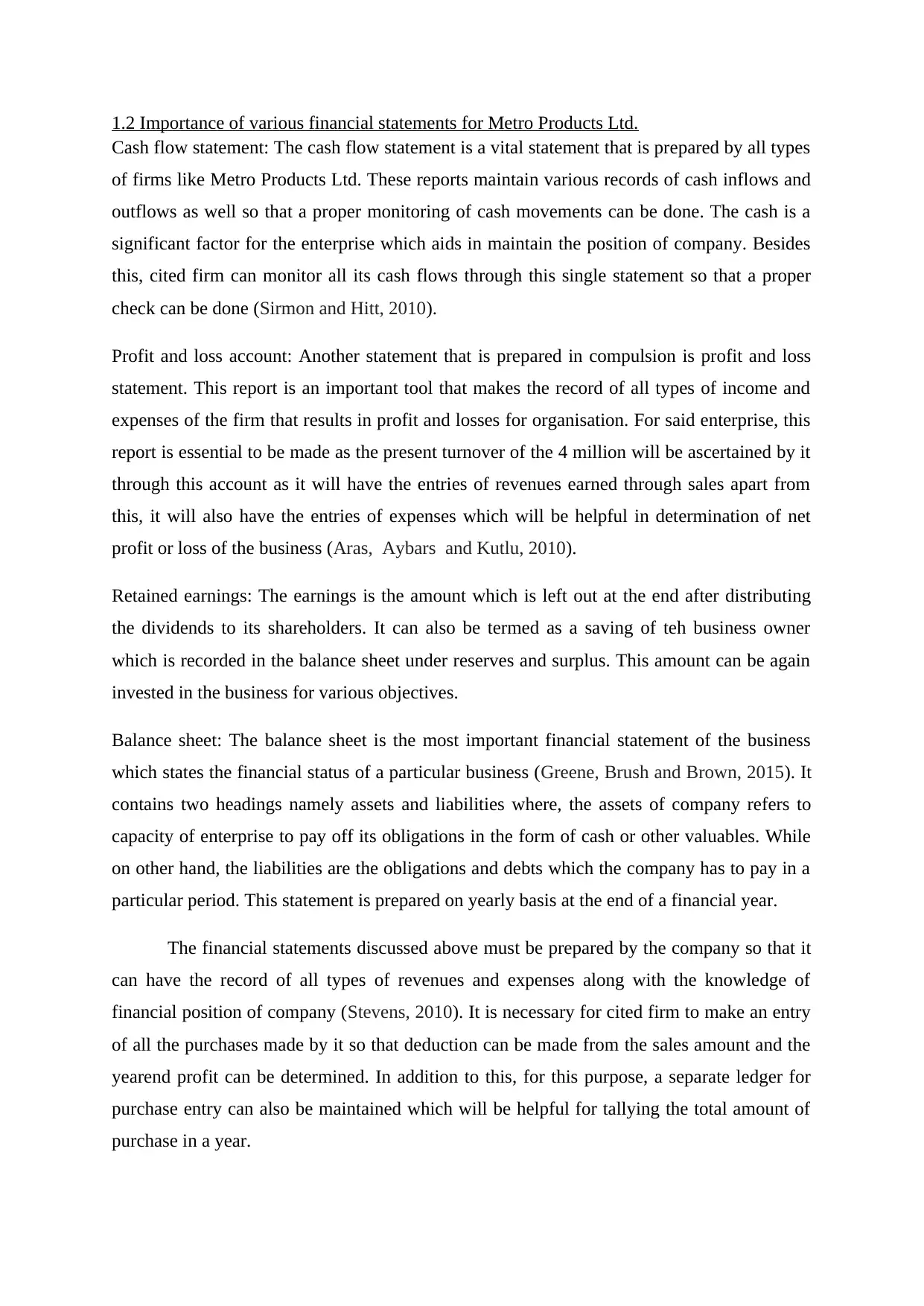
1.2 Importance of various financial statements for Metro Products Ltd.
Cash flow statement: The cash flow statement is a vital statement that is prepared by all types
of firms like Metro Products Ltd. These reports maintain various records of cash inflows and
outflows as well so that a proper monitoring of cash movements can be done. The cash is a
significant factor for the enterprise which aids in maintain the position of company. Besides
this, cited firm can monitor all its cash flows through this single statement so that a proper
check can be done (Sirmon and Hitt, 2010).
Profit and loss account: Another statement that is prepared in compulsion is profit and loss
statement. This report is an important tool that makes the record of all types of income and
expenses of the firm that results in profit and losses for organisation. For said enterprise, this
report is essential to be made as the present turnover of the 4 million will be ascertained by it
through this account as it will have the entries of revenues earned through sales apart from
this, it will also have the entries of expenses which will be helpful in determination of net
profit or loss of the business (Aras, Aybars and Kutlu, 2010).
Retained earnings: The earnings is the amount which is left out at the end after distributing
the dividends to its shareholders. It can also be termed as a saving of teh business owner
which is recorded in the balance sheet under reserves and surplus. This amount can be again
invested in the business for various objectives.
Balance sheet: The balance sheet is the most important financial statement of the business
which states the financial status of a particular business (Greene, Brush and Brown, 2015). It
contains two headings namely assets and liabilities where, the assets of company refers to
capacity of enterprise to pay off its obligations in the form of cash or other valuables. While
on other hand, the liabilities are the obligations and debts which the company has to pay in a
particular period. This statement is prepared on yearly basis at the end of a financial year.
The financial statements discussed above must be prepared by the company so that it
can have the record of all types of revenues and expenses along with the knowledge of
financial position of company (Stevens, 2010). It is necessary for cited firm to make an entry
of all the purchases made by it so that deduction can be made from the sales amount and the
yearend profit can be determined. In addition to this, for this purpose, a separate ledger for
purchase entry can also be maintained which will be helpful for tallying the total amount of
purchase in a year.
Cash flow statement: The cash flow statement is a vital statement that is prepared by all types
of firms like Metro Products Ltd. These reports maintain various records of cash inflows and
outflows as well so that a proper monitoring of cash movements can be done. The cash is a
significant factor for the enterprise which aids in maintain the position of company. Besides
this, cited firm can monitor all its cash flows through this single statement so that a proper
check can be done (Sirmon and Hitt, 2010).
Profit and loss account: Another statement that is prepared in compulsion is profit and loss
statement. This report is an important tool that makes the record of all types of income and
expenses of the firm that results in profit and losses for organisation. For said enterprise, this
report is essential to be made as the present turnover of the 4 million will be ascertained by it
through this account as it will have the entries of revenues earned through sales apart from
this, it will also have the entries of expenses which will be helpful in determination of net
profit or loss of the business (Aras, Aybars and Kutlu, 2010).
Retained earnings: The earnings is the amount which is left out at the end after distributing
the dividends to its shareholders. It can also be termed as a saving of teh business owner
which is recorded in the balance sheet under reserves and surplus. This amount can be again
invested in the business for various objectives.
Balance sheet: The balance sheet is the most important financial statement of the business
which states the financial status of a particular business (Greene, Brush and Brown, 2015). It
contains two headings namely assets and liabilities where, the assets of company refers to
capacity of enterprise to pay off its obligations in the form of cash or other valuables. While
on other hand, the liabilities are the obligations and debts which the company has to pay in a
particular period. This statement is prepared on yearly basis at the end of a financial year.
The financial statements discussed above must be prepared by the company so that it
can have the record of all types of revenues and expenses along with the knowledge of
financial position of company (Stevens, 2010). It is necessary for cited firm to make an entry
of all the purchases made by it so that deduction can be made from the sales amount and the
yearend profit can be determined. In addition to this, for this purpose, a separate ledger for
purchase entry can also be maintained which will be helpful for tallying the total amount of
purchase in a year.
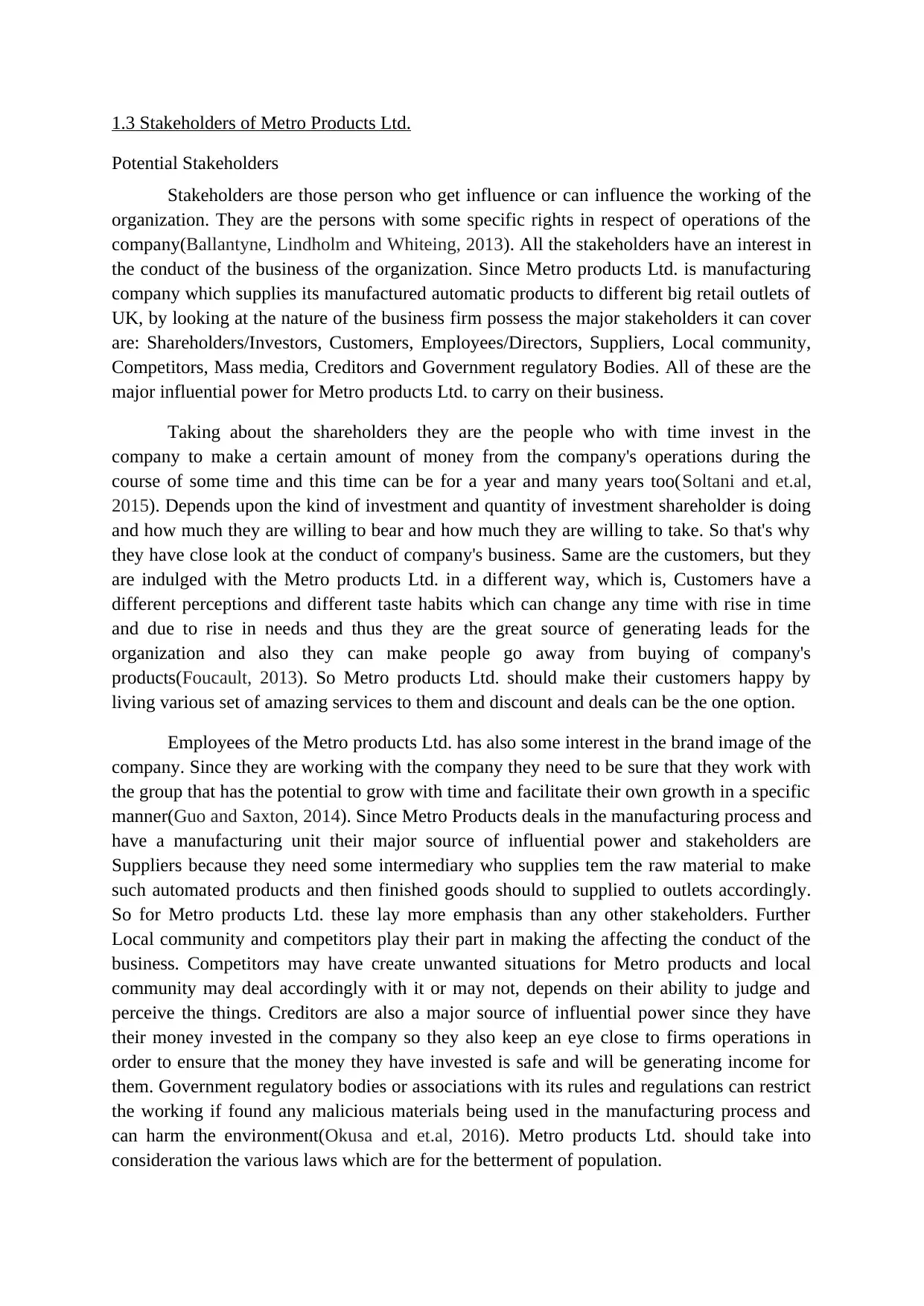
1.3 Stakeholders of Metro Products Ltd.
Potential Stakeholders
Stakeholders are those person who get influence or can influence the working of the
organization. They are the persons with some specific rights in respect of operations of the
company(Ballantyne, Lindholm and Whiteing, 2013). All the stakeholders have an interest in
the conduct of the business of the organization. Since Metro products Ltd. is manufacturing
company which supplies its manufactured automatic products to different big retail outlets of
UK, by looking at the nature of the business firm possess the major stakeholders it can cover
are: Shareholders/Investors, Customers, Employees/Directors, Suppliers, Local community,
Competitors, Mass media, Creditors and Government regulatory Bodies. All of these are the
major influential power for Metro products Ltd. to carry on their business.
Taking about the shareholders they are the people who with time invest in the
company to make a certain amount of money from the company's operations during the
course of some time and this time can be for a year and many years too(Soltani and et.al,
2015). Depends upon the kind of investment and quantity of investment shareholder is doing
and how much they are willing to bear and how much they are willing to take. So that's why
they have close look at the conduct of company's business. Same are the customers, but they
are indulged with the Metro products Ltd. in a different way, which is, Customers have a
different perceptions and different taste habits which can change any time with rise in time
and due to rise in needs and thus they are the great source of generating leads for the
organization and also they can make people go away from buying of company's
products(Foucault, 2013). So Metro products Ltd. should make their customers happy by
living various set of amazing services to them and discount and deals can be the one option.
Employees of the Metro products Ltd. has also some interest in the brand image of the
company. Since they are working with the company they need to be sure that they work with
the group that has the potential to grow with time and facilitate their own growth in a specific
manner(Guo and Saxton, 2014). Since Metro Products deals in the manufacturing process and
have a manufacturing unit their major source of influential power and stakeholders are
Suppliers because they need some intermediary who supplies tem the raw material to make
such automated products and then finished goods should to supplied to outlets accordingly.
So for Metro products Ltd. these lay more emphasis than any other stakeholders. Further
Local community and competitors play their part in making the affecting the conduct of the
business. Competitors may have create unwanted situations for Metro products and local
community may deal accordingly with it or may not, depends on their ability to judge and
perceive the things. Creditors are also a major source of influential power since they have
their money invested in the company so they also keep an eye close to firms operations in
order to ensure that the money they have invested is safe and will be generating income for
them. Government regulatory bodies or associations with its rules and regulations can restrict
the working if found any malicious materials being used in the manufacturing process and
can harm the environment(Okusa and et.al, 2016). Metro products Ltd. should take into
consideration the various laws which are for the betterment of population.
Potential Stakeholders
Stakeholders are those person who get influence or can influence the working of the
organization. They are the persons with some specific rights in respect of operations of the
company(Ballantyne, Lindholm and Whiteing, 2013). All the stakeholders have an interest in
the conduct of the business of the organization. Since Metro products Ltd. is manufacturing
company which supplies its manufactured automatic products to different big retail outlets of
UK, by looking at the nature of the business firm possess the major stakeholders it can cover
are: Shareholders/Investors, Customers, Employees/Directors, Suppliers, Local community,
Competitors, Mass media, Creditors and Government regulatory Bodies. All of these are the
major influential power for Metro products Ltd. to carry on their business.
Taking about the shareholders they are the people who with time invest in the
company to make a certain amount of money from the company's operations during the
course of some time and this time can be for a year and many years too(Soltani and et.al,
2015). Depends upon the kind of investment and quantity of investment shareholder is doing
and how much they are willing to bear and how much they are willing to take. So that's why
they have close look at the conduct of company's business. Same are the customers, but they
are indulged with the Metro products Ltd. in a different way, which is, Customers have a
different perceptions and different taste habits which can change any time with rise in time
and due to rise in needs and thus they are the great source of generating leads for the
organization and also they can make people go away from buying of company's
products(Foucault, 2013). So Metro products Ltd. should make their customers happy by
living various set of amazing services to them and discount and deals can be the one option.
Employees of the Metro products Ltd. has also some interest in the brand image of the
company. Since they are working with the company they need to be sure that they work with
the group that has the potential to grow with time and facilitate their own growth in a specific
manner(Guo and Saxton, 2014). Since Metro Products deals in the manufacturing process and
have a manufacturing unit their major source of influential power and stakeholders are
Suppliers because they need some intermediary who supplies tem the raw material to make
such automated products and then finished goods should to supplied to outlets accordingly.
So for Metro products Ltd. these lay more emphasis than any other stakeholders. Further
Local community and competitors play their part in making the affecting the conduct of the
business. Competitors may have create unwanted situations for Metro products and local
community may deal accordingly with it or may not, depends on their ability to judge and
perceive the things. Creditors are also a major source of influential power since they have
their money invested in the company so they also keep an eye close to firms operations in
order to ensure that the money they have invested is safe and will be generating income for
them. Government regulatory bodies or associations with its rules and regulations can restrict
the working if found any malicious materials being used in the manufacturing process and
can harm the environment(Okusa and et.al, 2016). Metro products Ltd. should take into
consideration the various laws which are for the betterment of population.
⊘ This is a preview!⊘
Do you want full access?
Subscribe today to unlock all pages.

Trusted by 1+ million students worldwide
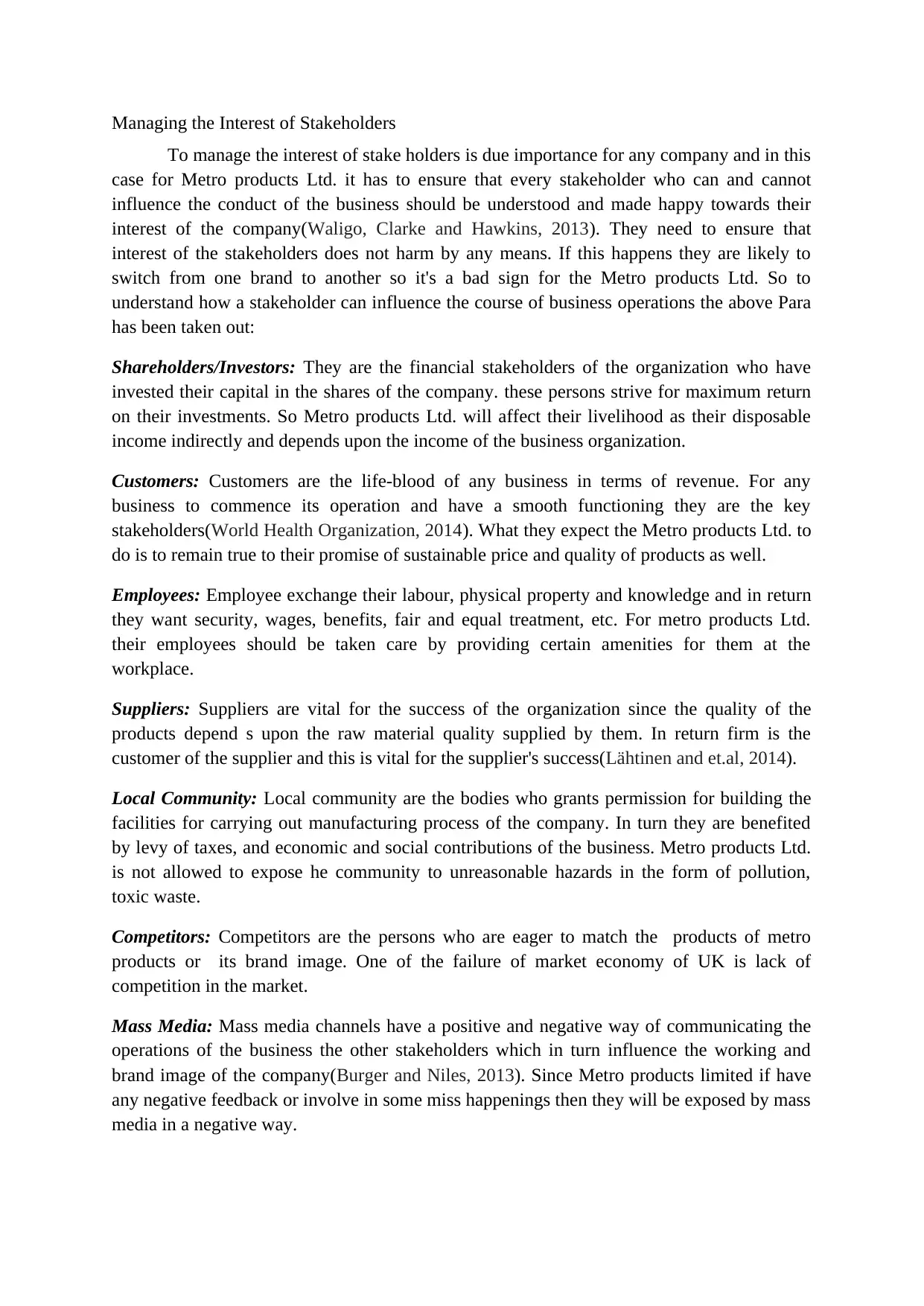
Managing the Interest of Stakeholders
To manage the interest of stake holders is due importance for any company and in this
case for Metro products Ltd. it has to ensure that every stakeholder who can and cannot
influence the conduct of the business should be understood and made happy towards their
interest of the company(Waligo, Clarke and Hawkins, 2013). They need to ensure that
interest of the stakeholders does not harm by any means. If this happens they are likely to
switch from one brand to another so it's a bad sign for the Metro products Ltd. So to
understand how a stakeholder can influence the course of business operations the above Para
has been taken out:
Shareholders/Investors: They are the financial stakeholders of the organization who have
invested their capital in the shares of the company. these persons strive for maximum return
on their investments. So Metro products Ltd. will affect their livelihood as their disposable
income indirectly and depends upon the income of the business organization.
Customers: Customers are the life-blood of any business in terms of revenue. For any
business to commence its operation and have a smooth functioning they are the key
stakeholders(World Health Organization, 2014). What they expect the Metro products Ltd. to
do is to remain true to their promise of sustainable price and quality of products as well.
Employees: Employee exchange their labour, physical property and knowledge and in return
they want security, wages, benefits, fair and equal treatment, etc. For metro products Ltd.
their employees should be taken care by providing certain amenities for them at the
workplace.
Suppliers: Suppliers are vital for the success of the organization since the quality of the
products depend s upon the raw material quality supplied by them. In return firm is the
customer of the supplier and this is vital for the supplier's success(Lähtinen and et.al, 2014).
Local Community: Local community are the bodies who grants permission for building the
facilities for carrying out manufacturing process of the company. In turn they are benefited
by levy of taxes, and economic and social contributions of the business. Metro products Ltd.
is not allowed to expose he community to unreasonable hazards in the form of pollution,
toxic waste.
Competitors: Competitors are the persons who are eager to match the products of metro
products or its brand image. One of the failure of market economy of UK is lack of
competition in the market.
Mass Media: Mass media channels have a positive and negative way of communicating the
operations of the business the other stakeholders which in turn influence the working and
brand image of the company(Burger and Niles, 2013). Since Metro products limited if have
any negative feedback or involve in some miss happenings then they will be exposed by mass
media in a negative way.
To manage the interest of stake holders is due importance for any company and in this
case for Metro products Ltd. it has to ensure that every stakeholder who can and cannot
influence the conduct of the business should be understood and made happy towards their
interest of the company(Waligo, Clarke and Hawkins, 2013). They need to ensure that
interest of the stakeholders does not harm by any means. If this happens they are likely to
switch from one brand to another so it's a bad sign for the Metro products Ltd. So to
understand how a stakeholder can influence the course of business operations the above Para
has been taken out:
Shareholders/Investors: They are the financial stakeholders of the organization who have
invested their capital in the shares of the company. these persons strive for maximum return
on their investments. So Metro products Ltd. will affect their livelihood as their disposable
income indirectly and depends upon the income of the business organization.
Customers: Customers are the life-blood of any business in terms of revenue. For any
business to commence its operation and have a smooth functioning they are the key
stakeholders(World Health Organization, 2014). What they expect the Metro products Ltd. to
do is to remain true to their promise of sustainable price and quality of products as well.
Employees: Employee exchange their labour, physical property and knowledge and in return
they want security, wages, benefits, fair and equal treatment, etc. For metro products Ltd.
their employees should be taken care by providing certain amenities for them at the
workplace.
Suppliers: Suppliers are vital for the success of the organization since the quality of the
products depend s upon the raw material quality supplied by them. In return firm is the
customer of the supplier and this is vital for the supplier's success(Lähtinen and et.al, 2014).
Local Community: Local community are the bodies who grants permission for building the
facilities for carrying out manufacturing process of the company. In turn they are benefited
by levy of taxes, and economic and social contributions of the business. Metro products Ltd.
is not allowed to expose he community to unreasonable hazards in the form of pollution,
toxic waste.
Competitors: Competitors are the persons who are eager to match the products of metro
products or its brand image. One of the failure of market economy of UK is lack of
competition in the market.
Mass Media: Mass media channels have a positive and negative way of communicating the
operations of the business the other stakeholders which in turn influence the working and
brand image of the company(Burger and Niles, 2013). Since Metro products limited if have
any negative feedback or involve in some miss happenings then they will be exposed by mass
media in a negative way.
Paraphrase This Document
Need a fresh take? Get an instant paraphrase of this document with our AI Paraphraser
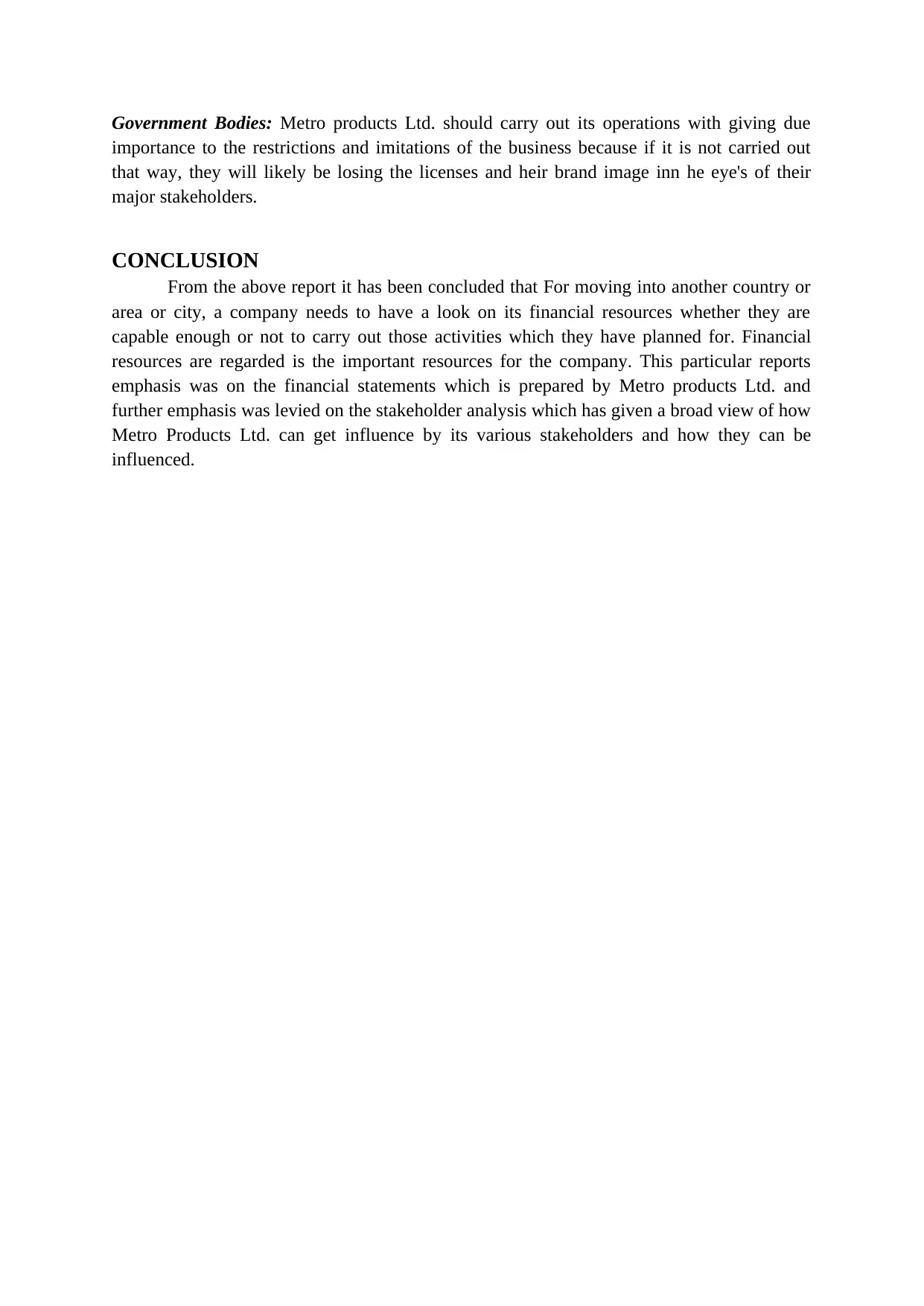
Government Bodies: Metro products Ltd. should carry out its operations with giving due
importance to the restrictions and imitations of the business because if it is not carried out
that way, they will likely be losing the licenses and heir brand image inn he eye's of their
major stakeholders.
CONCLUSION
From the above report it has been concluded that For moving into another country or
area or city, a company needs to have a look on its financial resources whether they are
capable enough or not to carry out those activities which they have planned for. Financial
resources are regarded is the important resources for the company. This particular reports
emphasis was on the financial statements which is prepared by Metro products Ltd. and
further emphasis was levied on the stakeholder analysis which has given a broad view of how
Metro Products Ltd. can get influence by its various stakeholders and how they can be
influenced.
importance to the restrictions and imitations of the business because if it is not carried out
that way, they will likely be losing the licenses and heir brand image inn he eye's of their
major stakeholders.
CONCLUSION
From the above report it has been concluded that For moving into another country or
area or city, a company needs to have a look on its financial resources whether they are
capable enough or not to carry out those activities which they have planned for. Financial
resources are regarded is the important resources for the company. This particular reports
emphasis was on the financial statements which is prepared by Metro products Ltd. and
further emphasis was levied on the stakeholder analysis which has given a broad view of how
Metro Products Ltd. can get influence by its various stakeholders and how they can be
influenced.
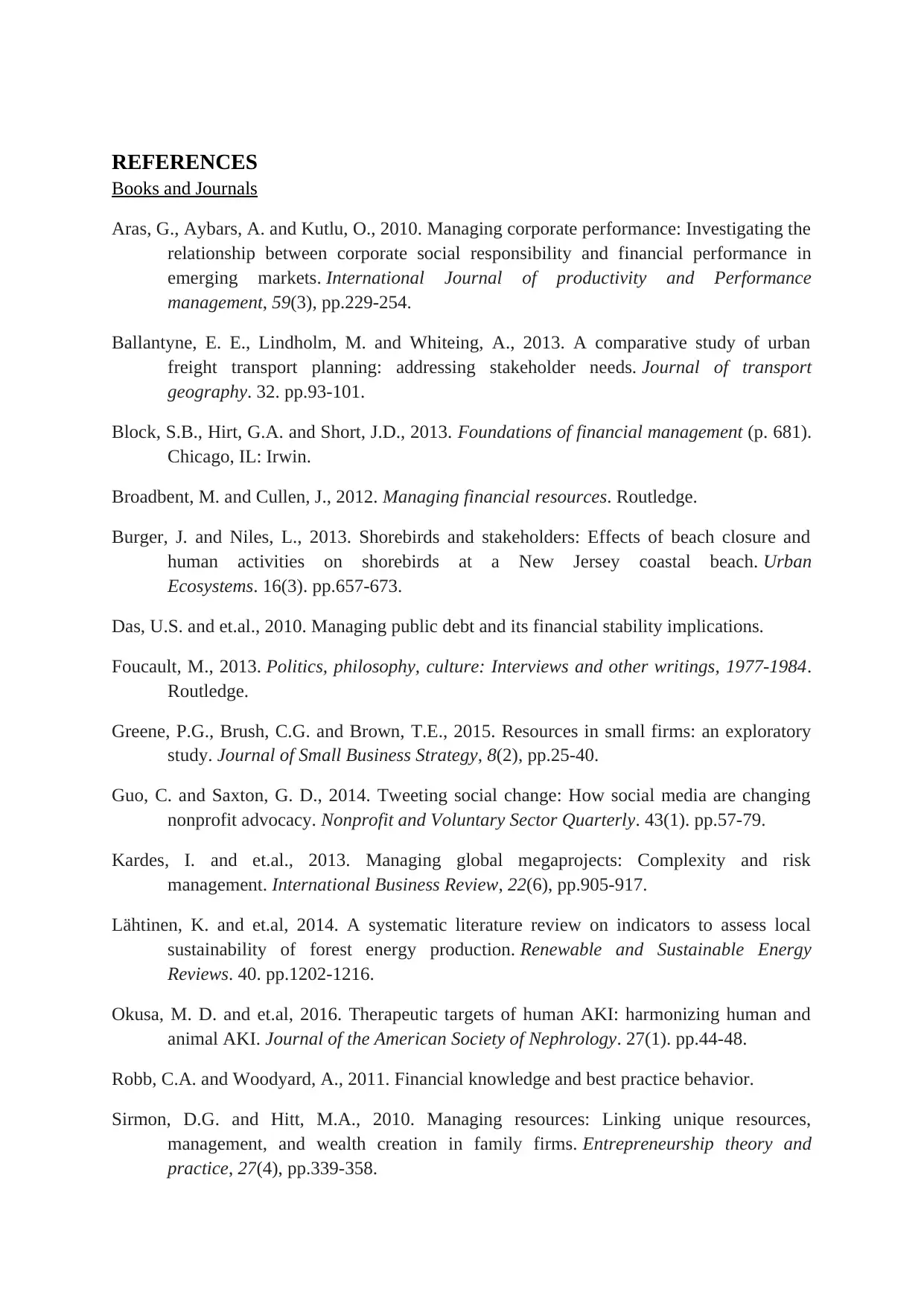
REFERENCES
Books and Journals
Aras, G., Aybars, A. and Kutlu, O., 2010. Managing corporate performance: Investigating the
relationship between corporate social responsibility and financial performance in
emerging markets. International Journal of productivity and Performance
management, 59(3), pp.229-254.
Ballantyne, E. E., Lindholm, M. and Whiteing, A., 2013. A comparative study of urban
freight transport planning: addressing stakeholder needs. Journal of transport
geography. 32. pp.93-101.
Block, S.B., Hirt, G.A. and Short, J.D., 2013. Foundations of financial management (p. 681).
Chicago, IL: Irwin.
Broadbent, M. and Cullen, J., 2012. Managing financial resources. Routledge.
Burger, J. and Niles, L., 2013. Shorebirds and stakeholders: Effects of beach closure and
human activities on shorebirds at a New Jersey coastal beach. Urban
Ecosystems. 16(3). pp.657-673.
Das, U.S. and et.al., 2010. Managing public debt and its financial stability implications.
Foucault, M., 2013. Politics, philosophy, culture: Interviews and other writings, 1977-1984.
Routledge.
Greene, P.G., Brush, C.G. and Brown, T.E., 2015. Resources in small firms: an exploratory
study. Journal of Small Business Strategy, 8(2), pp.25-40.
Guo, C. and Saxton, G. D., 2014. Tweeting social change: How social media are changing
nonprofit advocacy. Nonprofit and Voluntary Sector Quarterly. 43(1). pp.57-79.
Kardes, I. and et.al., 2013. Managing global megaprojects: Complexity and risk
management. International Business Review, 22(6), pp.905-917.
Lähtinen, K. and et.al, 2014. A systematic literature review on indicators to assess local
sustainability of forest energy production. Renewable and Sustainable Energy
Reviews. 40. pp.1202-1216.
Okusa, M. D. and et.al, 2016. Therapeutic targets of human AKI: harmonizing human and
animal AKI. Journal of the American Society of Nephrology. 27(1). pp.44-48.
Robb, C.A. and Woodyard, A., 2011. Financial knowledge and best practice behavior.
Sirmon, D.G. and Hitt, M.A., 2010. Managing resources: Linking unique resources,
management, and wealth creation in family firms. Entrepreneurship theory and
practice, 27(4), pp.339-358.
Books and Journals
Aras, G., Aybars, A. and Kutlu, O., 2010. Managing corporate performance: Investigating the
relationship between corporate social responsibility and financial performance in
emerging markets. International Journal of productivity and Performance
management, 59(3), pp.229-254.
Ballantyne, E. E., Lindholm, M. and Whiteing, A., 2013. A comparative study of urban
freight transport planning: addressing stakeholder needs. Journal of transport
geography. 32. pp.93-101.
Block, S.B., Hirt, G.A. and Short, J.D., 2013. Foundations of financial management (p. 681).
Chicago, IL: Irwin.
Broadbent, M. and Cullen, J., 2012. Managing financial resources. Routledge.
Burger, J. and Niles, L., 2013. Shorebirds and stakeholders: Effects of beach closure and
human activities on shorebirds at a New Jersey coastal beach. Urban
Ecosystems. 16(3). pp.657-673.
Das, U.S. and et.al., 2010. Managing public debt and its financial stability implications.
Foucault, M., 2013. Politics, philosophy, culture: Interviews and other writings, 1977-1984.
Routledge.
Greene, P.G., Brush, C.G. and Brown, T.E., 2015. Resources in small firms: an exploratory
study. Journal of Small Business Strategy, 8(2), pp.25-40.
Guo, C. and Saxton, G. D., 2014. Tweeting social change: How social media are changing
nonprofit advocacy. Nonprofit and Voluntary Sector Quarterly. 43(1). pp.57-79.
Kardes, I. and et.al., 2013. Managing global megaprojects: Complexity and risk
management. International Business Review, 22(6), pp.905-917.
Lähtinen, K. and et.al, 2014. A systematic literature review on indicators to assess local
sustainability of forest energy production. Renewable and Sustainable Energy
Reviews. 40. pp.1202-1216.
Okusa, M. D. and et.al, 2016. Therapeutic targets of human AKI: harmonizing human and
animal AKI. Journal of the American Society of Nephrology. 27(1). pp.44-48.
Robb, C.A. and Woodyard, A., 2011. Financial knowledge and best practice behavior.
Sirmon, D.G. and Hitt, M.A., 2010. Managing resources: Linking unique resources,
management, and wealth creation in family firms. Entrepreneurship theory and
practice, 27(4), pp.339-358.
⊘ This is a preview!⊘
Do you want full access?
Subscribe today to unlock all pages.

Trusted by 1+ million students worldwide
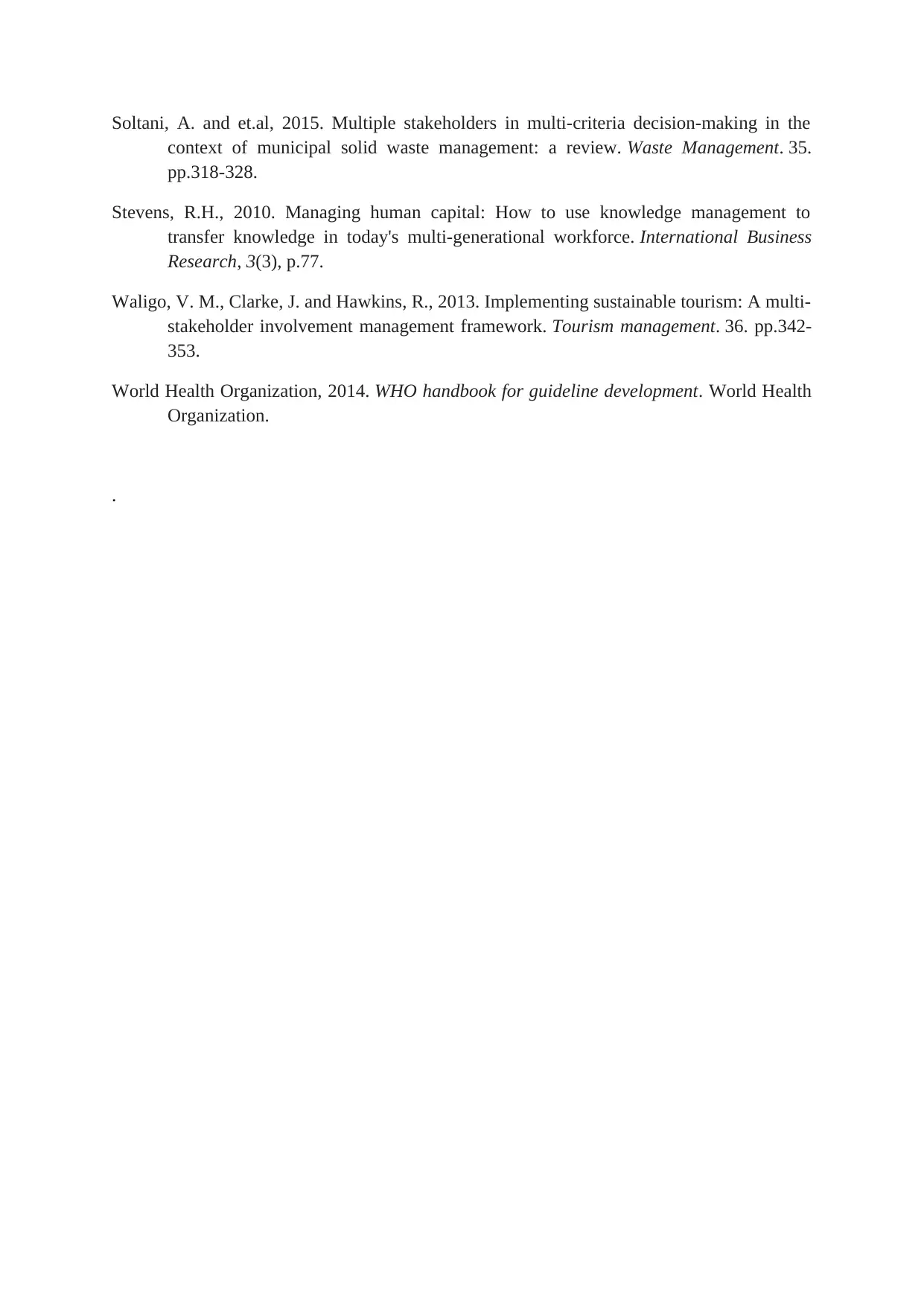
Soltani, A. and et.al, 2015. Multiple stakeholders in multi-criteria decision-making in the
context of municipal solid waste management: a review. Waste Management. 35.
pp.318-328.
Stevens, R.H., 2010. Managing human capital: How to use knowledge management to
transfer knowledge in today's multi-generational workforce. International Business
Research, 3(3), p.77.
Waligo, V. M., Clarke, J. and Hawkins, R., 2013. Implementing sustainable tourism: A multi-
stakeholder involvement management framework. Tourism management. 36. pp.342-
353.
World Health Organization, 2014. WHO handbook for guideline development. World Health
Organization.
.
context of municipal solid waste management: a review. Waste Management. 35.
pp.318-328.
Stevens, R.H., 2010. Managing human capital: How to use knowledge management to
transfer knowledge in today's multi-generational workforce. International Business
Research, 3(3), p.77.
Waligo, V. M., Clarke, J. and Hawkins, R., 2013. Implementing sustainable tourism: A multi-
stakeholder involvement management framework. Tourism management. 36. pp.342-
353.
World Health Organization, 2014. WHO handbook for guideline development. World Health
Organization.
.
1 out of 10
Related Documents
Your All-in-One AI-Powered Toolkit for Academic Success.
+13062052269
info@desklib.com
Available 24*7 on WhatsApp / Email
![[object Object]](/_next/static/media/star-bottom.7253800d.svg)
Unlock your academic potential
Copyright © 2020–2025 A2Z Services. All Rights Reserved. Developed and managed by ZUCOL.





